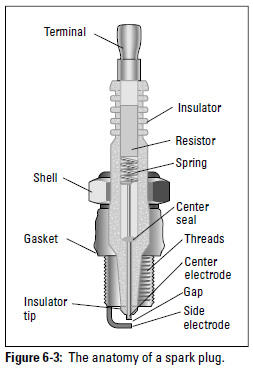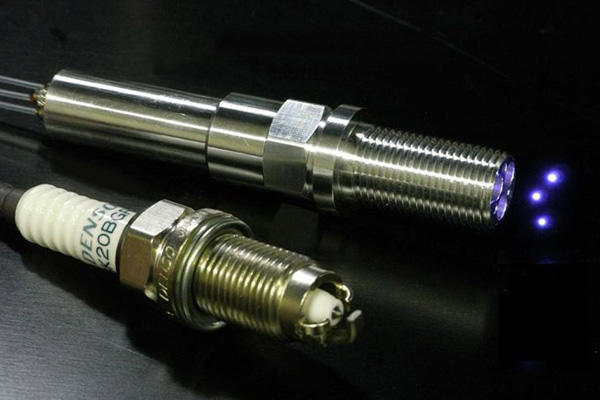You can (and should) actually read your spark plugs for valuable "clues" about how your engine is operating. To read your spark plugs, follow these steps:
1. When you get the first spark plug out of the engine, remove the plug from the spark plug socket and compare the condition of the plug to the clues in Table 6-1. Figure 6-3 can help you to identify the various parts of a plug mentioned in the table.
2. Check the plug's shell, insulator, and gaskets for signs of cracking or chipping, which indicate that the plug should be replaced.
3. Look at the plug's firing end (the end that was inside the cylinder). As you can see in Figure 6-3, the hook at the top is the side electrode, and the bump right under its tip is called the center electrode. The spark comes up the center of the plug and jumps the gap between these two electrodes. This gap must be a particular distance across for your engine to run efficiently.

4. Take your wire or taper feeler gauge and locate the proper wire. (If your spark-plug gap specifications say .035, look for this number on the gauge.) Then slip that part of the gauge between the two electrodes on your old plug.
If the gauge has a lot of room to wiggle around, it may be because your old plug has worn down its center electrode, causing a gap that's too large. If the gauge can't fit between the center and side electrodes, the gap is too small, which means that the spark plug isn't burning the fuel/air mixture efficiently.
| Table 6-1 | What Your Old Spark Plugs Tell You about Your Vehicle | ||
| Condition | Clues | Probable Causes | Remedies |
| Normal plug | Brown or grayish-tan deposit on side electrode | Everything's fine | Just clean and regap the plug. |
| Carbon-fouled plug | Black, dry, fluffy soot on insulator tip and electrodes | Overly rich fuel/air mixture, dirty air filter, too much driving at low speeds, or idling for a long time | Switch to "hotter" plugs. (The higher the plug number, the hotter the plug.) |
| Oil-fouled plug | Wet, black, oily deposits on insulator tip and electrodes | Oil may be leaking into cylinders past worn pistons on poorly adjusted or worn valves | Clean and regap the plug, or replace it, but find out where the leak is coming from. |
| Burned plug | Blisters on insulator tip, melted electrodes, burned stuff | Engine overheating gap is too wide, wrong or loose plugs, overly lean fuel/air misture, or incorrect timing | Replace the plug. |
| Worn plug | Severely eroded or worn electrodes | Plug has been in there too long | Replace the plug. |
5. Look at the center electrode bump again and use Table 6-1 to judge itscondition.
Is it nice and cylindrical, like the center electrodes on your new spark plugs? Has the electrode's flat top worn down to a rounded lump? Or has it worn down on only one side? Chances are it's pretty worn because it's old. When the center electrode wears down, the gap becomes too large. (When you do this job yourself, you'll probably check your plugs more often and replace them before they get too worn to operate efficiently.)
6. Clean the plug by gently scrubbing it with a wire brush.
7. Either gap or replace the old plug with a new one.
Keep in mind that although you don't need to clean new spark plugs, you do need to gap them. Some plugs are sold "pre-gapped," but I recommend checking them with a feeler gauge anyway.
8. Repeat the entire process for each additional plug.
Work on only one plug at a time, and don't remove a plug unless the one you just dealt with — or its replacement — is safely back in the engine.
Tip: To keep your engine operating efficiently, don't mix plugs in varying states of wear. Either replace all the plugs with new ones or clean and reinstall all the old ones. If you find that a few of your old plugs aren't too worn and are in fairly good shape but you need to replace the others, clean and regap the salvageable plugs and store them in your trunk compartment tool kit for emergencies.
Sometimes you can cure a problem — such as carbon-fouled plugs — by going to a hotter- or cooler-burning plug. You can identify these by the plug number: The higher the number, the hotter the plug. Never go more than one step hotter or cooler at a time.
If your plugs indicate that something is seriously wrong with the way your engine is running, ask a professional for an opinion. If you're told that it requires extensive or expensive work, get a second opinion at another service facility without telling the technicians that you went to the first place. This is a good policy to follow whenever major repair work is suggested. You wisely get a second opinion when a doctor tells you that you need major surgery; why not give your vehicle the same thorough attention before incurring a major expense?
From Auto Repair for Dummies, copyright © 2009 by Wiley Publishing, Inc., Indianapolis, Indiana. Used by arrangement with John Wiley & Sons, Inc.










